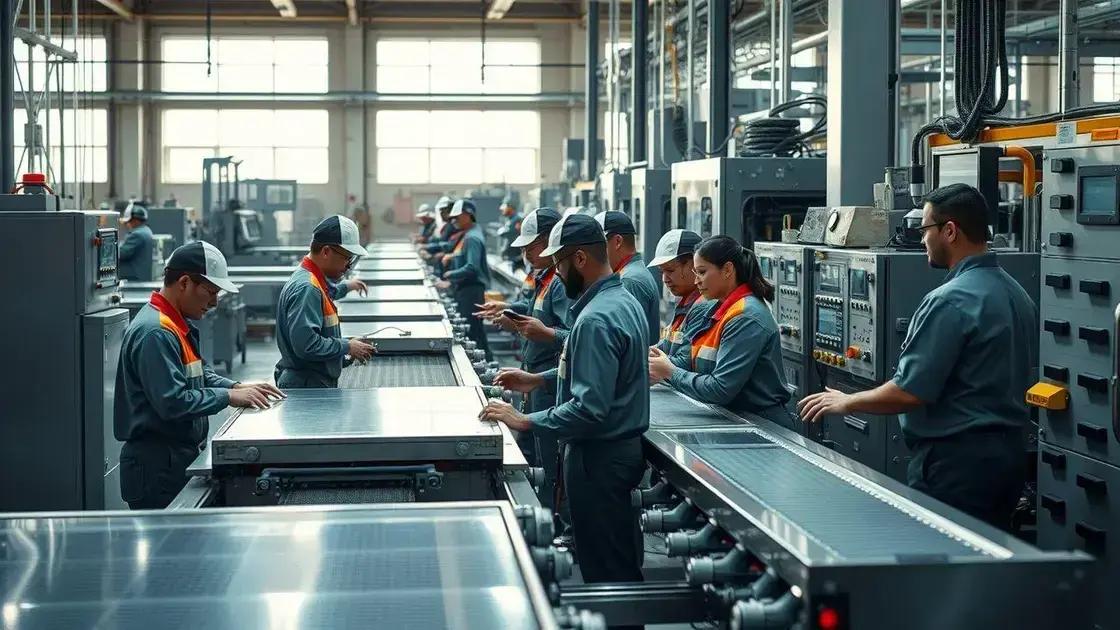Biden’s initiative to revitalize American manufacturing

Biden’s initiative to revitalize American manufacturing aims to create jobs, enhance innovation, and promote sustainability by focusing on advanced technologies and supporting key sectors like green energy and healthcare.
Biden’s initiative to revitalize American manufacturing is more than just a policy change; it’s a transformative effort to boost the economy. Have you ever wondered how this plan may affect local jobs and the innovation landscape? Let’s dive deeper.
Overview of Biden’s plan
The Overview of Biden’s plan to revitalize American manufacturing focuses on several key areas aimed at strengthening the industry and boosting job creation. This initiative is more than a mere response to economic challenges; it represents a commitment to achieving sustainable growth and enhancing the global competitiveness of the United States. Let’s explore the main components of this comprehensive plan.
Key Components of the Plan
Biden’s strategy encompasses a series of targeted investments and reforms. Below are some essential facets that outline his vision:
- Investment in advanced manufacturing technology to improve efficiency.
- Incentives for companies to bring production back to the U.S.
- Support for workforce development and training programs.
- Focus on green technologies and sustainability in manufacturing.
In addition to these components, the plan emphasizes the importance of collaboration between government, industry, and academia. This collaborative approach aims to foster innovation and ensure that American manufacturing remains at the forefront of technological advancement. By leveraging resources from various sectors, Biden aims to create a robust ecosystem where businesses can thrive.
Economic Impact
The expected economic impact from this initiative is significant. By revitalizing the manufacturing sector, the plan could lead to millions of new jobs being created across the country. This not only benefits individuals and their families but strengthens local and national economies as well. The resurgence of manufacturing is seen as a means to reduce dependency on foreign supply chains, which has become increasingly critical in recent years.
As Biden’s administration moves forward, monitoring the implementation of this plan will be crucial. The ability to adapt to challenges and seize opportunities will determine the success of these initiatives aimed at reviving American manufacturing. The focus will remain on not only creating jobs but also on ensuring these jobs support a sustainable future.
Expected impact on American jobs
The expected impact on American jobs from Biden’s initiative to revitalize manufacturing is substantial and far-reaching. This plan is designed to create opportunities across various sectors, aimed at putting Americans back to work. With the injection of federal resources and support, many industries are poised for growth, leading to a surge in job openings.
Job Creation Opportunities
Among the critical areas of focus are the following:
- Advanced manufacturing: Enhanced technology and automation will create new roles in tech and operational management.
- Green energy: The push for sustainable practices will demand skilled workers to build solar panels, wind turbines, and other eco-friendly products.
- Workforce training: Programs aimed at skill development will prepare workers for modern manufacturing jobs.
- Support jobs: Increased demand in manufacturing will generate additional roles in logistics, sales, and service industries.
The initiative also aims to empower young workers and those transitioning from declining industries. By investing in training and educational programs, the plan seeks to ensure that everyone has the skills needed to succeed in the evolving job market. This is particularly crucial as technology continues to reshape the manufacturing landscape.
Long-term Benefits
In the long run, revitalizing manufacturing will not only create immediate job opportunities but will also lead to stable career paths for many individuals. These new roles will contribute to local economies and foster community development. As manufacturing grows, the positive effects will ripple through various sectors, ultimately benefiting everyone.
Furthermore, a strong manufacturing base can bolster national security by reducing dependence on foreign production. This stability ensures that American workers remain at the forefront of innovation and production in a globalized economy.
Key sectors targeted for revitalization

The key sectors targeted for revitalization under Biden’s manufacturing plan are essential for transforming the American economy. By focusing on specific industries, the initiative aims to ensure targeted growth while promoting innovation and sustainability. Each sector plays a unique role in providing jobs and fostering economic stability.
Advanced Manufacturing
This sector includes industries that utilize cutting-edge technology to enhance production processes. Companies are encouraged to adopt innovative methods, increasing efficiency and output. Job roles in this area will require more skilled workers, leading to an emphasis on education and training programs.
Green Technologies
With a heightened focus on combating climate change, the green technology sector is a key component of the revitalization effort. This includes:
- Renewable energy: Solar and wind power production need skilled workers for installation and maintenance.
- Energy-efficient products: Manufacturing items like LED lights and energy-saving appliances will be prioritized.
- Sustainable materials: The push for biodegradable and recyclable materials in production is growing.
The integration of green technologies not only aids in environmental protection but also creates new job opportunities in emerging industries. These roles are essential as the nation shifts towards a more sustainable future.
Healthcare and Medical Devices
Another vital area targeted for revitalization is the production of healthcare goods. The ongoing demand for medical devices, pharmaceuticals, and personal protective equipment has highlighted the need for robust domestic manufacturing capabilities. Investing in this sector can lead to:
- Increased production of essential medical supplies.
- Creation of jobs in research and development.
- Better supply chain management for healthcare products.
This focus ensures that America is better prepared for future public health crises while simultaneously promoting economic growth.
By emphasizing these key sectors, Biden’s initiative aims to create a more diversified and resilient manufacturing base. The future of American manufacturing hinges on the ability to innovate and adapt to market needs while ensuring jobs are accessible to a wide range of workers.
Challenges in implementation
The challenges in implementation of Biden’s initiative to revitalize American manufacturing are significant and multifaceted. While the goals are ambitious, several obstacles must be addressed to ensure the success of this plan.
Supply Chain Disruptions
One major challenge is the ongoing disruptions in global supply chains. These disruptions can lead to delays in obtaining essential materials and components needed for manufacturing. If companies cannot secure timely shipments, production schedules may be affected. To combat this, strengthening domestic supply chains is crucial.
Skilled Labor Shortage
Another pressing issue is the shortage of skilled labor. As industries evolve and adopt advanced technologies, there is a growing need for workers who possess specialized skills. The following strategies may help mitigate this challenge:
- Investment in education: Initiatives that support technical education and training programs can prepare the workforce for new roles.
- Partnerships with community colleges: Collaborations between manufacturers and educational institutions can create tailored training solutions.
- Attracting younger workers: Engaging younger generations in manufacturing jobs can help fill the talent gap.
Addressing this skills gap is essential to ensuring that the manufacturing sector can thrive in the coming years.
Regulatory Hurdles
Regulatory challenges can also hinder progress. Compliance with existing regulations and the adoption of new laws can create barriers for manufacturers. Companies must navigate a complex landscape of rules related to environmental impact, labor practices, and safety standards. Simplifying these regulations while ensuring accountability may help streamline operations.
Financial Constraints
Finally, financial constraints can be a significant hurdle. Many manufacturers may require substantial investments to modernize their facilities and processes. Securing funding can be difficult, especially for smaller companies. Government grants and incentives can play a vital role in easing this burden, but scattered resources might slow down the overall progress.
By addressing these challenges head-on, the initiative has the potential to realize its goals and revitalize American manufacturing effectively. Each hurdle presents an opportunity for innovative solutions that can strengthen the industry’s foundation.
Future outlook for American manufacturing
The future outlook for American manufacturing is promising as the country embraces new technologies and innovative practices. With the right strategies in place, the manufacturing sector can emerge stronger and more resilient. The focus on modernization and sustainability will be vital for driving growth in this industry.
Continued Technological Advancements
As technology continues to evolve, American manufacturers will increasingly adopt automation and digital tools. These advancements can lead to:
- Improved efficiency: Automation streamlines production processes, allowing companies to produce goods faster.
- Data-driven decision-making: Utilizing data analytics can help manufacturers optimize operations and reduce costs.
- Enhanced product quality: Advanced technologies lead to higher precision and consistency in production.
By staying at the forefront of technological change, manufacturers can compete effectively in the global market.
Sustainability Initiatives
Another crucial aspect of the future landscape is the emphasis on sustainability. As consumer preferences shift towards more environmentally friendly products, manufacturers will likely focus on eco-friendly practices. This involves:
- Investing in renewable energy sources.
- Reducing waste in production processes.
- Implementing recycling initiatives to create a circular economy.
These sustainability initiatives not only serve the planet but also resonate with environmentally conscious consumers, creating a new market opportunity.
Reshape Workforce Dynamics
The workforce in manufacturing is evolving as well. With demands for skilled labor increasing, there will be greater emphasis on education and training. Programs aimed at upskilling employees can help meet the needs of advanced manufacturing. Engaging younger workers in these fields can also foster innovation and growth.
Overall, the future of American manufacturing looks bright. With a strong focus on technology, sustainability, and workforce development, the sector is poised to thrive in a rapidly changing global economy. Adaptability and a forward-thinking approach will be essential for long-term success.
FAQ – Frequently Asked Questions about Biden’s Initiative to Revitalize American Manufacturing
What are the main goals of Biden’s manufacturing initiative?
The main goals are to create jobs, boost innovation, and enhance sustainability in the manufacturing sector.
How will technology impact American manufacturing?
Technology will improve efficiency and productivity through automation and data analytics, leading to better-quality products.
What challenges does the manufacturing sector currently face?
Key challenges include supply chain disruptions, a shortage of skilled labor, and regulatory hurdles.
How can sustainability be achieved in manufacturing?
By adopting renewable energy sources and implementing eco-friendly practices, manufacturers can reduce their environmental impact.






